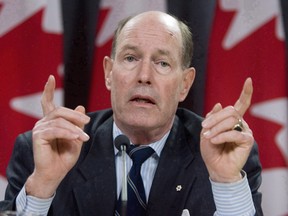Rising bond yields are putting Ottawa on a costly path when it comes to servicing the debt
Article content
The sharp escalation of global bond yields in recent weeks raises the prospect we may be in the middle of a structural shift to a world of permanently higher borrowing costs.
If true, it would represent a fresh blow to Canadian government finances that only reinforces the need for much more careful budget management from Prime Minister Justin Trudeau’s administration, including the reestablishment of some sort of fiscal anchor.
Advertisement 2
Article content
Article content
Global interest rates have been marching higher all summer, with bond yields up almost a full percentage point since April in both the U.S. and Canada to levels not seen since 2007.
Even if they don’t rise further from here, markets are signalling the era of super-low borrowing costs that has prevailed since the Great Financial Crisis may be over.
This poses a problem for the federal government, whose heavy borrowing over the past three years was premised on the idea that interest rates would remain at historically low levels.
Finance Minister Chrystia Freeland’s budget earlier this year projected that government borrowing rates would settle in between 2.5 per cent and three per cent, depending on duration. Right now, bond yields are ranging from 3.5 per cent on the 30-year bond to 4.8 per cent on two years.
Should these rates persist, the impact on the nation’s fiscal path would be meaningful.
According to the finance department’s own sensitivity analysis, a one percentage point increase in interest rates would add $3.8 billion in charges in the first year, with the cost rising to $10.3 billion in five years.
Article content
Advertisement 3
Article content
The net impact on the bottom line would be lower than that, as higher public debt charges are partly offset by some additional revenue for the government that comes with higher interest rates.
According to the same sensitivity analysis, a percentage point increase in rates would increase the deficit by $4 billion in year one and up to $6.9 billion by year five. The total cost would exceed $25 billion over five years, a not-insignificant amount.
It would eclipse, for example, all the gains the government is expecting to make from its much-heralded efforts to find $15 billion in savings in the fiscal framework over the next five years.
The federal government will continue to claim the trajectory is sustainable, since the debt to GDP ratio will still be on a downward path, albeit a slower one.
There’s little sign, after all, that Canada’s access to capital markets is being constrained by its fiscal plan — which is the ultimate test of sustainability.
Still, the higher interest rate environment will make it increasingly tougher to argue the current trajectory is a prudent one.
Advertisement 4
Article content
Prudence is the act of being cautious even if disaster isn’t the most probable scenario — in part because no one really knows what lies ahead. Prudent policy is the foundation of sustainable finances and it’s a bar the Trudeau government was already struggling to hit even before the recent escalation in borrowing costs.
Freeland’s last budget in March has faced some criticism for being too optimistic in its revenue projections. There are some doubts whether the government will be able to keep future spending in check as much as promised in the face of surging population growth. The higher borrowing costs add to these concerns.
“There is downside risk to their projection,” Mostafa Askari, chief economist at the University of Ottawa’s Institute of Fiscal Studies and Democracy, told me recently in a phone call.
Trudeau’s government emerged from their cabinet retreat last week talking tough about how fiscal responsibility is the foundation of their agenda.
As a guardrail for policy, former Bank of Canada Governor David Dodge has proposed a 10 per cent prudence rule as an anchor for the federal government, whereby debt service charges are kept at no more than one-tenth of revenue.
Advertisement 5
Article content
-

Rate hike shows BoC fighting to stay ahead of curve on inflation
-

Why BoC is likely to overdo it in fight against inflation
-

Why Canada has plenty of leverage as China relations sour
The March budget had projected interest payments would remain below that threshold throughout the forecasting horizon. But the increase in global bond yields has put it on a path to breach Dodge’s rule, perhaps permanently, without additional fiscal adjustments.
The government flagging this breach as a key concern in its coming fiscal update would go a long way in displaying they are ready to back their tough talk with action.
Theo Argitis is managing director at Compass Rose Group
Article content
Will Trudeau’s government breach the David Dodge Rule?
2023-08-28 11:10:36






Comments
Postmedia is committed to maintaining a lively but civil forum for discussion and encourage all readers to share their views on our articles. Comments may take up to an hour for moderation before appearing on the site. We ask you to keep your comments relevant and respectful. We have enabled email notifications—you will now receive an email if you receive a reply to your comment, there is an update to a comment thread you follow or if a user you follow comments. Visit our Community Guidelines for more information and details on how to adjust your email settings.
Join the Conversation